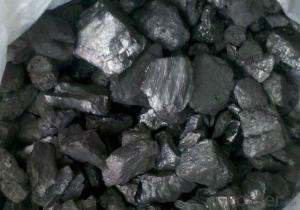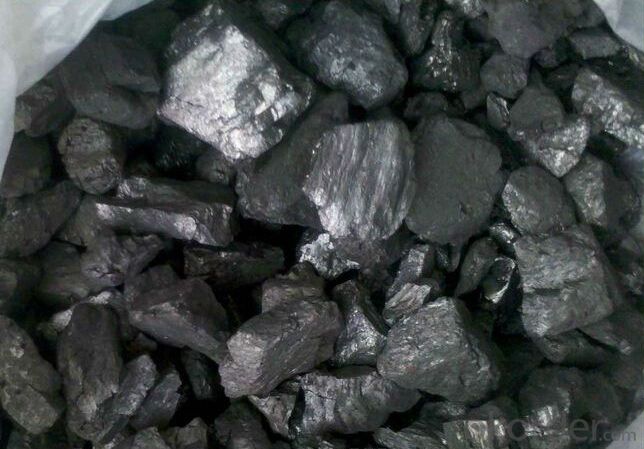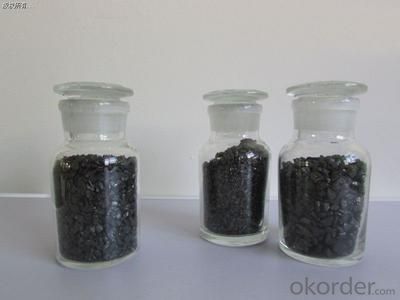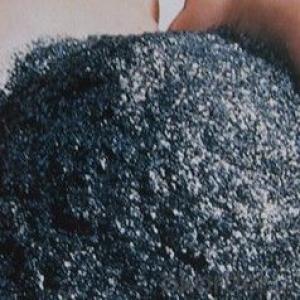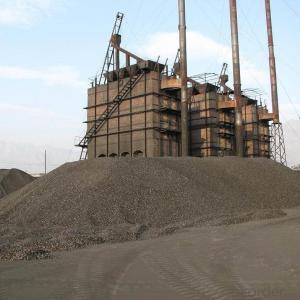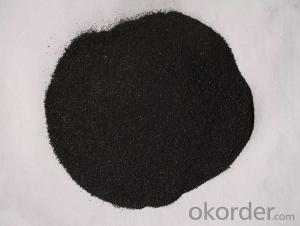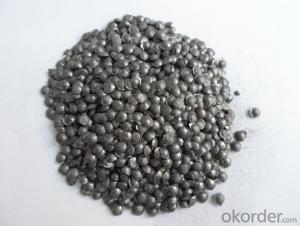Carbon additive for steel making and foundary low sulfur high carbon graphite carbon raiser
- Loading Port:
- Qingdao
- Payment Terms:
- TT OR LC
- Min Order Qty:
- 10 m.t
- Supply Capability:
- 500000 m.t/month
OKorder Service Pledge
OKorder Financial Service
You Might Also Like
Specifications of Carbide Additive:
- carbon 90%,92%,93%,95%min, sulfur 0.35%,0.3%,0.25%max
- Short delivery time, flexible payment,good quality,competitive price
Gas Calcined Anthracite/ carbon raiser:
Specs:
Grades | Chemicals Composition(%) | ||||
F.C. | S | Ash | V.M. | Moisture | |
%(min) | %(max) | ||||
1# 2# 3# 4# | 95.00 93.00 92.00 90.00 | 0.25 0.30 0.30 0.35 | 3.50 5.50 6.50 8.00 | 1.50 1.50 1.50 2.00 | 0.80 |
Size | 0-1mm, 0-5mm,1-4mm, 1-5mm, 2-8mm, >10mm or at customer's option; | ||||
Packing | In 1MT big bag or 25kgs bag then in 1MT big bag, or at customers’ option | ||||
Features:
We used the best quality anthracite as raw materials through high temperature calcined at over 2000 by the DC electric calciner with results in eliminating the moisture and volatile matter from anthracite efficiently, improving the density and the electric conductivity and strengthening the mechanical strength and anti-oxidation. It has good characteristics with low ash, low resistivity, low sulphur, high carbon and high density. It is the best material for high quality carbon products.
Application:
It is used as carbon additive in steel industry or fuel.
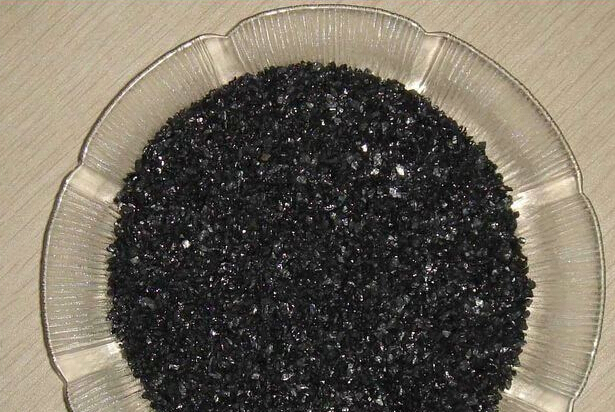
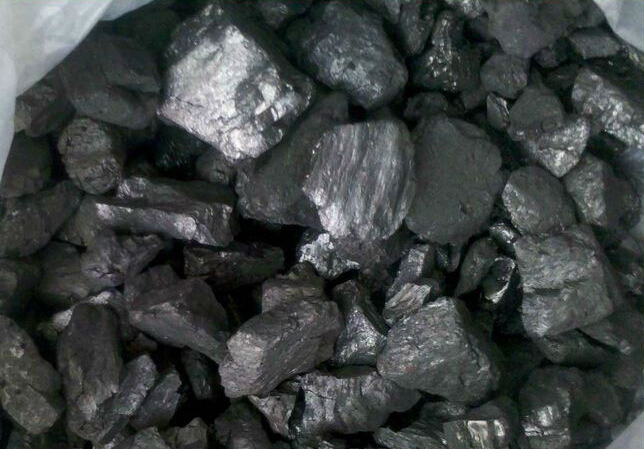

- Q: What kinds of barbecue carbon do you have?
- The disadvantage is more expensive. Ordinary charcoal advantages are cheap, disadvantages are different sizes, barbecue uneven fire, burning time is short, the process of baking carbon must be added. The mechanism of carbon is actually a mixture of carbon and coal, pressed into the multi hollow prism, from carbon containing ash on the look out the composition of coal.
- Q: What are the different types of carbon-based polymers?
- Carbon-based polymers come in various types, each possessing unique properties and applications. Some commonly encountered variants include: 1. Polyethylene (PE): Esteemed for its exceptional strength and chemical resistance, PE is extensively utilized in packaging materials, plastic bottles, and pipes. 2. Polypropylene (PP): PP is akin to PE, but it boasts a higher melting point and superior heat resistance. This makes it a popular choice for automotive parts, textiles, and food packaging. 3. Polystyrene (PS): PS is a lightweight and rigid polymer frequently employed in packaging materials, disposable utensils, and insulation. 4. Polyvinyl chloride (PVC): PVC is a versatile polymer that can be either rigid or flexible based on the additives employed. It finds common application in pipes, electrical insulation, and flooring. 5. Polyethylene terephthalate (PET): PET is a robust and lightweight polymer commonly found in beverage bottles, food containers, and synthetic fibers. 6. Polyurethane (PU): PU is a flexible and durable polymer utilized in foams, coatings, adhesives, and textiles. 7. Polycarbonate (PC): PC is a robust and transparent polymer regularly utilized in eyeglass lenses, safety goggles, and electronic components. 8. Phenolic resins: Renowned for their exceptional heat resistance, these polymers are commonly employed in coatings, adhesives, and electrical components. These examples represent only a fraction of the diverse range of carbon-based polymers available. Each type possesses specific properties and applications, rendering them suitable for a wide array of industries and products.
- Q: How does carbon impact food production?
- Carbon impacts food production in several ways. Firstly, carbon dioxide (CO2) is a major greenhouse gas that contributes to climate change. Increased levels of CO2 in the atmosphere lead to higher temperatures, altered rainfall patterns, and more frequent extreme weather events, all of which can negatively affect crop growth and productivity. For example, excessive heat can reduce crop yields and quality, while intense rainfall or droughts can cause flooding or water scarcity, respectively, both of which can damage crops and reduce agricultural productivity. Furthermore, carbon emissions from agricultural practices, such as the use of synthetic fertilizers, deforestation for agriculture, and livestock production, contribute to the overall carbon footprint of the food system. These emissions exacerbate climate change, creating a vicious cycle where climate change negatively impacts food production, while food production contributes to climate change. Additionally, carbon emissions from the transportation and processing of food also impact its production. The transportation of food over long distances, often involving the use of fossil fuels, results in carbon emissions. Similarly, the processing and packaging of food require energy, often derived from fossil fuels, which further contributes to carbon emissions. To mitigate the carbon impact on food production, sustainable agricultural practices need to be adopted. This includes practices such as agroforestry, organic farming, and precision agriculture, which can help sequester carbon in soils, reduce the reliance on synthetic fertilizers, and improve overall soil health. Additionally, reducing food waste and promoting local and seasonal food consumption can reduce carbon emissions associated with transportation and processing. Overall, carbon impacts food production through its contribution to climate change and associated extreme weather events, as well as through emissions generated from agricultural practices and food processing. Addressing these impacts is crucial for ensuring food security and sustainability in the face of climate change.
- Q: How does carbon impact the prevalence of tropical storms?
- Carbon, specifically in the form of carbon dioxide (CO2) emissions, plays a significant role in impacting the prevalence of tropical storms. The increase in atmospheric CO2 levels due to human activities such as burning fossil fuels, deforestation, and industrial processes has led to the phenomenon known as global warming. This rise in global temperatures has several implications for the formation and intensity of tropical storms. Firstly, warmer temperatures cause an increase in the evaporation of seawater, resulting in higher levels of moisture in the atmosphere. Moisture is a crucial factor in the development of tropical storms, as it provides the necessary fuel for their formation and sustenance. With more moisture available, the potential for tropical storms to develop and strengthen is enhanced. Additionally, rising global temperatures lead to the expansion of the warm tropical oceans, providing a larger area for tropical storms to form and intensify. This expansion allows for a greater exchange of energy between the ocean and the atmosphere, further enhancing the potential for storm development. Furthermore, elevated levels of CO2 contribute to ocean acidification, which has detrimental effects on marine ecosystems, including coral reefs. Coral reefs act as natural barriers that protect coastal areas from storm surges and waves generated by tropical storms. However, the acidification of oceans weakens and destroys these reefs, leaving coastal regions more vulnerable to the impacts of storms. Lastly, climate change caused by carbon emissions alters atmospheric and oceanic circulation patterns, which can affect the movement and tracks of tropical storms. Changes in wind patterns and ocean currents may cause storms to deviate from their traditional paths, leading to increased uncertainty and potential impacts on regions that are not typically prone to these events. In summary, carbon emissions and the subsequent global warming they cause have significant impacts on the prevalence of tropical storms. Increased moisture content, expanded warm ocean areas, weakened coastal defenses, and altered storm tracks are all consequences of rising carbon levels, which ultimately contribute to more frequent and intense tropical storms.
- Q: How does carbon monoxide affect human health?
- Human health can be severely impacted by carbon monoxide, a highly toxic gas. When we breathe it in, carbon monoxide enters our bloodstream and binds with hemoglobin, the molecule responsible for delivering oxygen to our cells. This binding is incredibly strong and hampers the effective delivery of oxygen, resulting in a condition known as carboxyhemoglobinemia. The symptoms of carbon monoxide poisoning can vary depending on the concentration and duration of exposure. Initially, individuals may experience mild symptoms like headaches, fatigue, dizziness, and nausea. However, if exposure continues or occurs at higher concentrations, these symptoms can escalate to confusion, impaired judgment, loss of consciousness, and even death. One of the most dangerous aspects of carbon monoxide is its ability to go unnoticed, as it lacks color, odor, and taste. This makes it difficult to detect its presence without proper monitoring equipment. Carbon monoxide poisoning can arise from various sources, including faulty heating systems, poorly ventilated appliances, and running engines in enclosed spaces. Prolonged or repeated exposure to carbon monoxide can result in long-term health consequences. It can lead to neurological damage, memory loss, cognitive impairment, and even permanent brain damage. Additionally, it can worsen existing cardiovascular conditions, increasing the chances of heart attacks and strokes. To safeguard ourselves from carbon monoxide poisoning, it is crucial to ensure proper ventilation and functional carbon monoxide detectors in our homes and workplaces. Regular maintenance of appliances and heating systems is also essential to minimize the risk of leaks. Recognizing the symptoms of carbon monoxide poisoning and seeking immediate medical attention are vital in preventing severe health outcomes.
- Q: How does carbon contribute to the flavor of food?
- There are multiple ways in which carbon, found in charcoal or charred substances, can enhance the flavor of food. Firstly, when food is cooked over charcoal, the carbon gives it a smoky taste and aroma, which enhances the overall flavor. This smokiness is particularly desirable in dishes such as barbecued meats, vegetables, and certain cheeses, as it adds a unique and enjoyable element to the taste. Additionally, carbon can serve as a natural filter, absorbing and eliminating impurities from food and drinks. This filtration process helps to get rid of unpleasant smells and flavors, resulting in a cleaner and more refined taste. For instance, activated carbon is often used in the production of alcoholic beverages like whiskey or vodka to remove impurities and create a smoother and more flavorful drink. Moreover, carbon can contribute to the development of desirable texture and color in certain foods. When sugar or other carbohydrates are heated, they undergo caramelization, a process in which the sugars react with heat to form a complex mixture of carbon compounds. This caramelization process creates rich, golden-brown hues and a unique depth of flavor, enhancing the overall taste experience. Lastly, carbon plays a crucial role in the fermentation process, which is essential in producing various types of food and drinks. During fermentation, microorganisms consume sugars and release carbon dioxide, which contributes to the texture, flavor, and carbonation of the final product. This is particularly evident in bread, beer, wine, and other fermented foods, where the presence of carbon dioxide adds lightness, complexity, and effervescence to the flavor. To summarize, carbon enhances the flavor of food through its ability to impart smokiness, act as a natural filter, facilitate caramelization, and participate in fermentation processes. Its presence in different forms enhances the taste, texture, and overall enjoyment of a wide range of food and drinks.
- Q: Carbon injection molding machine heating several degrees
- The nozzle temperature is 260~310 degrees, and the temperature control of the two types of injection molding machine nozzles is different. The mold temperature has great influence on the mechanical properties of the products. With the increase of mold temperature. The temperature and the temperature difference between the temperature decreases, the shear stress decreases, can melt in the mold cavity slow cooling, the molecular chain orientation to relaxation reduced, thereby reducing the internal stress of products, but the impact strength and elongation of the products decreased significantly, while there will be demolding. When demoulding, it is easy to deform, prolong the molding cycle and reduce the production efficiency, while the lower mold temperature will increase the internal stress of the product. Therefore, the die temperature must be controlled. Normally, the mold temperature of PC is 80~120 degrees centigrade. Ordinary products are controlled at 80~100 degrees, while for complex shapes, thin walls and high requirements, the product is controlled at 100~120 degrees centigrade and is not allowed to exceed its thermal deformation temperature. Mold temperature control is particularly important when forming PC thick wall products.
- Q: Search for a summary of the importance of carbon in life. If you write well, you can add points,
- The carbon containing compounds exist in hundreds of thousands, divided into inorganic and organic compounds in two categories, known as carbon containing inorganic substances in daily life and industrial and agricultural production is the raw material of carbon calcium carbonate as food additive sodium, sodium bicarbonate, calcium carbonate and lime material acetylene gas (acetylene), chemical fertilizer ammonium bicarbonate, chemical gases such as carbon dioxide.
- Q: How can we reduce carbon emissions from transportation?
- To mitigate climate change and improve air quality, it is crucial to reduce carbon emissions from transportation. Achieving this goal can be done through various strategies: 1. The promotion of electric vehicles (EVs) is key. Encouraging the adoption of electric cars, buses, and bikes can lead to a significant reduction in carbon emissions. Governments can make EVs more affordable by providing incentives like tax credits, rebates, and subsidies. Additionally, expanding the charging infrastructure network is essential to ease range anxiety and increase the adoption of EVs. 2. Investing in public transportation is another effective strategy. Enhancing and expanding public transportation systems can reduce the number of individual vehicles on the road, resulting in fewer emissions. Governments should prioritize the development of efficient and accessible public transport networks, including buses, trains, and trams. 3. Active transportation, such as walking and cycling, should be encouraged. These modes of transport can significantly reduce carbon emissions from short-distance trips. Building safe and convenient infrastructure like bike lanes and pedestrian-friendly streets can promote active transportation. 4. Improving fuel efficiency is crucial. Encouraging the production and purchase of vehicles with higher fuel efficiency standards can greatly reduce carbon emissions. Governments should enforce strict regulations and offer incentives to manufacturers producing fuel-efficient vehicles. 5. The development and promotion of alternative fuels can help reduce carbon emissions from transportation. Investing in alternative fuels like biofuels, hydrogen, and renewable natural gas is necessary. Governments should provide incentives and support research and development efforts to accelerate the adoption of these cleaner fuels. 6. Implementing congestion pricing and road tolls can discourage unnecessary car trips and reduce carbon emissions. Charging drivers for using congested roads or entering specific areas can encourage the use of public transportation or carpooling. 7. Promoting telecommuting and flexible work arrangements can reduce commuting trips and, consequently, carbon emissions. Governments and businesses can offer incentives to encourage companies to adopt these practices. 8. Rethinking urban planning is crucial. Designing cities and communities with mixed land-use patterns, where residential, commercial, and recreational areas are close by, can decrease the need for long commutes and promote active transportation. 9. Raising awareness and providing education about the environmental impact of transportation choices and the benefits of sustainable modes of transport is vital. Governments and organizations should launch campaigns to increase awareness and provide information about the carbon footprint of different transportation options. Reducing carbon emissions from transportation requires a comprehensive approach involving government policies, technological advancements, and changes in individual behavior. By implementing these strategies, significant progress can be made towards reducing carbon emissions and establishing a more sustainable transportation system.
- Q: What is carbon monoxide poisoning?
- Carbon monoxide poisoning is a potentially deadly condition that occurs when an individual inhales or is exposed to high levels of carbon monoxide gas. Carbon monoxide is a colorless, odorless, and tasteless gas that is produced from the incomplete combustion of carbon-based fuels such as gasoline, natural gas, coal, and wood. When carbon monoxide is inhaled, it enters the bloodstream and binds to hemoglobin, the molecule responsible for carrying oxygen throughout the body. This binding process prevents oxygen from being adequately delivered to vital organs and tissues, leading to oxygen deprivation or hypoxia. The symptoms of carbon monoxide poisoning can vary depending on the level and duration of exposure, but they often resemble those of the flu, including headache, dizziness, weakness, nausea, vomiting, confusion, and loss of consciousness. Prolonged exposure to high levels of carbon monoxide can result in severe brain damage, organ failure, and even death. It is crucial to take immediate action if carbon monoxide poisoning is suspected. This includes removing oneself from the source of exposure, seeking fresh air, and contacting emergency services for medical attention. Additionally, it is essential to identify and address the source of carbon monoxide, such as faulty heating systems, blocked chimneys, or malfunctioning appliances, to prevent further exposure and ensure the safety of the environment. Prevention is key in avoiding carbon monoxide poisoning. Regularly maintaining and inspecting fuel-burning appliances, installing carbon monoxide detectors in homes and buildings, and ensuring proper ventilation are vital steps to minimize the risk of exposure. Education and awareness about the dangers of carbon monoxide and the necessary precautions can help save lives and protect individuals from this silent killer.
Send your message to us
Carbon additive for steel making and foundary low sulfur high carbon graphite carbon raiser
- Loading Port:
- Qingdao
- Payment Terms:
- TT OR LC
- Min Order Qty:
- 10 m.t
- Supply Capability:
- 500000 m.t/month
OKorder Service Pledge
OKorder Financial Service
Similar products
Hot products
Hot Searches
Related keywords
